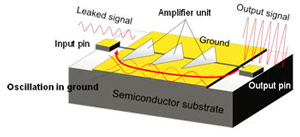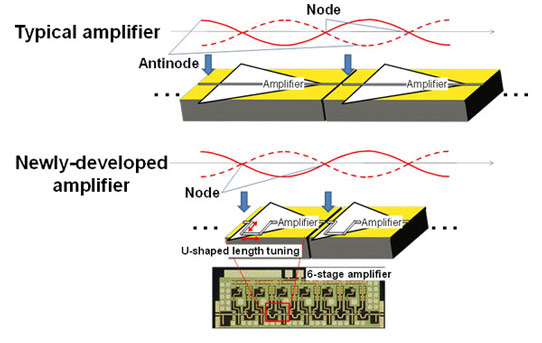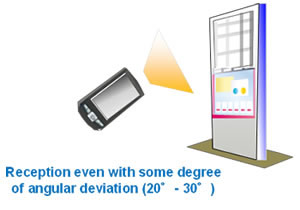- News
22 October 2013
Fujitsu develops InP HEMT-based receiver chip with sensitivity boosted tenfold
At the Compound Semiconductor IC Symposium (CSICS 2013) in Monterey, CA on 13 October, Japan’s Fujitsu Ltd and Fujitsu Laboratories Ltd presented details of a high-sensitivity receiver chip they have developed that, it is reckoned, will pave the way to high-capacity, gigabit-capable wireless devices operating at 240GHz in the millimeter-wave frequency band (30-300GHz).
The explosive growth of smartphones and other wireless devices has brought about an increase in the use of mobile data communications for browsing the web or downloading music, alongside conventional voice communication. With an expected shift toward high-capacity data communications, including videos and movies, it is expected that demand will grow for devices that can instantly download such data. For that to happen, high-capacity wireless devices will need to use wider frequency ranges. Wireless devices that could use millimeter-wave frequencies in the 240GHz band would be able to take advantage of a frequency range 100 times wider than that of the 0.8–2GHz range used by existing wireless devices, so they should also be able to handle communications speeds 100 times greater (i.e. a 100-fold increase in communications capacity).
However, millimeter-wave transmissions, particularly at such high frequencies as 240GHz, become severely attenuated as the radio waves travel through the air. Receiving such a faint signal requires a highly sensitive receiver (comprised of an antenna, amplifier, and wave detector). The introduction of an amplifier with a high amplification ratio has hence been sought as an effective way of improving reception sensitivity.
 Figure 1: Comparison of wavelengths.
Figure 1: Comparison of wavelengths.
A common way of increasing the amplification ratio of the amplifier is to connect multiple amplifiers as part of a staged construction. However, more stages result in bigger chip sizes. When applying this technique in the 240GHz band, the wavelength of the signal is very short (less than 1mm) so the length can be shorter than the chip itself (Figure 1). This creates technical problems that do not exist at the frequencies used by existing cell phones (that use the 2GHz band). Output signals from the amplifier can leak to ground on the chip’s surface, and these leaked signals return to the amplifier’s input pin, resulting in double amplification (Figure 2). When the leaked signal re-enters the amplifier, it is amplified again and produces even more signal leakage, which returns to the input pin yet again (creating the oscillator effect), making it difficult to receive these signals correctly. For this reason, creating a high amplification ratio with millimeter waves requires a technology that can suppress these oscillations without losing amplification levels.
 Figure 2: Signal leakage through ground.
Figure 2: Signal leakage through ground.
Building on indium phosphide high electron-mobility transistor (InP HEMT) technology developed by Fujitsu Laboratories, Fujitsu has developed a multi-stage amplifier that suppresses the oscillator effect while increasing the amplification ratio. Also developed was an impedance-matching technology that efficiently conveys the output signal from one stage to the next. The result is that the receiver chip’s sensitivity is increased by about tenfold over previous designs, enabling the reception of large data volumes by smartphones or other mobile devices using a compact antenna.
Key features of the technology are detailed as follows.
1 - Multi-stage amplifier suppresses oscillator effect, increases amplification ratio
The leaked signal from an amplifier will always have ‘anti-nodes’ (at specific sites where that signal is at its greatest amplitude) and ‘nodes’ (where it has no amplitude at all). If the amplifier’s input pin is located in a leaked signal’s anti-node, then a stronger leaked signal will feed back into the amplifier, creating the oscillation effect (Figure 3, top). Conversely, if the input pin is located in a node, the leaked signal has no amplitude, and the amplifier will not re-amplify the leaked signal. Fujitsu has aligned the input pin and output pin with the nodes in the leaked signal (Figure 3, bottom). Connecting amplifiers designed this way into multiple stages results in high amplification ratios without an oscillator effect.

Figure 3: A conventional amplifier and the newly developed amplifier.
2 - Impedance-matching technology efficiently transmits amplifier output signal to next stage
Efficiently transmitting the output signal from an amplifier to the next stage requires impedance matching on the lines that connect the amplifiers which, in turn, requires that the lines are of a uniform length. But aligning the input and output pins of the amplifiers with the nodes limits the dimensions of the amplifier, while the length requirements on the lines create another set of constraints, complicating the task of impedance matching. To resolve this problem, a U-shaped line was deployed and the length and width of the U were adjusted to enable impedance matching regardless of the limitations on the dimensions of the amplifier.
The above technologies have produced a roughly tenfold improvement in the sensitivity of a receiver chip compared with previous designs. These receivers could be used in smartphones and other wireless devices equipped with compact antennas, says Fujitsu. Also, because this would allow for antennas with broader relative directionality than existing devices, there would be no need to precisely align the transmitter to the handset (Figure 4), resulting in greater convenience for users.
 Figure 4: Scenario showing handset in use.
Figure 4: Scenario showing handset in use.
Fujitsu says it is working to develop a compact package that integrates an antenna along with a receiver chip based on this technology, with the goal of conducting transmission testing sometime in 2015 and practical applications around 2020.
The research results were achieved partly through ‘R&D Program on Multi-tens Gigabit Wireless Communication Technology at Subterahertz Frequencies’ (commissioned by Japan’s Ministry of Internal Affairs and Communications as part of its ‘Research and Development Project for Expansion of Radio Spectrum Resources’).


